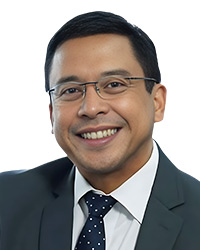With its GDP growing by 7.6% in 2022, the fastest rate among emerging Asean economies, the Philippines is facing increasing demands for energy. Against the backdrop of volatile oil prices, exploring for indigenous hydrocarbons must be a long-term policy of the Philippine government.
At the onset of the Bongbong Marcos administration, the Department of Energy (DOE) ushered in a new era of energy resource development via: issuing regulations to increase the renewable portfolio standards mandate; setting the renewable energy (RE) share in the total energy mix to 50% by 2040; directing the preferential dispatch of all RE resources; launching the Green Energy Auction Programme soliciting 11GW of new RE capacity; and opening the development of RE to 100% foreign-owned companies. While the DOE focused initially on RE, the Philippines needs to pursue programmes in the capital-intensive oil and gas exploration sector to avoid dependence on energy imports.
Energy demand and supply

Senior Partner
DivinaLaw
Nationally, oil and gas drive the transportation sector and are the primary fuels for power generation. Petroleum products now constitute 50.9% of the total final energy consumption in the Philippines, with the country importing 168,571 million barrels of petroleum products in 2022. Just 559 million barrels of oil were produced by the Galoc field, not even 1% of the country’s demand. Meanwhile, indigenous gas from Malampaya reservoir in Palawan is nearing depletion after 24 years of operations. The Malampaya Deep Water gas-to-power project accounts for 30% of power consumption in Luzon.
The Philippines has diverse geological basins that offer hydrocarbon resource potential. Of the 17 sedimentary basins however, not one can be considered extensively explored. Since the shift from a concession framework to a service contract system in 1972, only 263 exploration wells have been drilled, 41 resulting in oil discoveries while 11 were gas finds. This compares to the more than 250 wells drilled in one year by both Indonesia and Malaysia.
Policy overview & fiscal regime
Presidential Decree No. 87 (PD No. 87), or The Oil Exploration and Development Act of 1972, established the statutory framework of the Philippine upstream petroleum industry under which foreign and Filipino contractors carry out petroleum exploration under a service contract arrangement. Because the government is unable to finance exploration, the service contractor furnishes necessary technical services and financing for a fee of 40% of gross income after deducting all operating expenses. The remaining 60% is remitted by the contractor to the Philippine government as its share of the proceeds. The DOE reimburses the contractor for all expenses not exceeding 70% of the gross proceeds from production in any year. Any unreimbursed expenses are recovered from the operations of succeeding years.
While it sets out one of the most attractive fiscal regimes in Asia, the Philippines has mostly attracted only medium-sized foreign contractors, except for Shell and Chevron. PD No. 87 needs to adapt to the modern requirements of the upstream industry. The DOE must offer improved fiscal and contractual terms to investors to encourage more drilling activity.
One incentive is to allow for cross recovery where a deepwater contractor operates in two or more areas under different service contracts. The operating expenses may be recovered from the gross proceeds from the sale of all petroleum produced within any one or more of the projects, as if they are covered by a single contract. A previous bill in the Philippine Senate provided for this cross recovery that should attract exploration companies in the Philippines.
Another incentive is to mandate the government to assume the contractor’s income tax, which would dispel the cloud caused by the Commission on Audit decision denying the assumption by the government of the Malampaya project income tax.
Energy development reforms
Given the current state of hydrocarbon development, the DOE has undergone tremendous changes aimed at harnessing energy resources, implementing stricter regulatory measures, introducing substantial policies and paving the way for closer government agency coordination.
The DOE cancelled service contracts where the counterparty failed to abide by its contractual commitments. The Philippines has 17 active petroleum service contracts with only Galoc and Alegria producing oil. The DOE monitors every activity within each sub-phase outlined in the service contracts.
Recently, the DOE also launched the 2024 Philippine Bid Round for Coal, Petroleum and Native Hydrogen, offering prospective exploration areas with multiple surface geology, seismic and well reports for production of petroleum. With all these programmes, the Philippines hopes to harness indigenous petroleum resources. To attract foreign capital in exploration, the DOE needs to pursue its mandate, pushing for a plan that rests on the collaborative performance of various government agencies.
Jose M Layug Jr is a senior partner at DivinaLaw in Metro Manila

DIVINALAW
8th Floor Pacific Star Bldg,
Sen. Gil Puyat Ave.
cor Makati Ave,
Makati City 1200, Metro Manila, Philippines
Contact details:
Tel: ++632 8822 0808
E: jay.layug@divinalaw.com




























